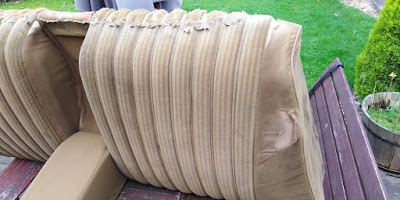The rear seat backrest in trimmed in 3 sections on a common frame - left, right and center armrest. This is very convenient with the Jersey rayé material as it allows for any deviation in the striped pattern to be adjusted to match the rear cushion, it also allows you to strip down and retrim one side at a time using the other side as a reference. The center armrest is secured on a folding assembly secured to the main framework by 2 countersunk screws and 2 plain screws with washers. The plain screws were found loose on disassembly - more on this later. After removing the screws a flap of material is secured by barbed tangs folded over a rod which is fed through a sleeve in the material. Folding back the tangs allows you to release the trim and remove the armrest.
 |
| Center armrest assembly secured to main framework |
The next 3 images show some labels which have been left in place for originality, I've not done any research on these but must have been used at the factory for production purposes.

 |
| Material removed from around top of backrest and the foam padding has vanished |
The center armrest is basically a foam topped wooden frame which is secured to the metal assembly by 4 screws and nuts, removing these allows removal of the trim material which was secured by staples.
Started working on the right hand side for no reason. More barbed tangs secure the top of the seat cover, bending the tangs back allow you to release the top of the cover. The rest of the cover is secured by hog rings onto the metal framework, remove the hog rings and the cover slips off. As with the seat cushion previously, the foam on the backrest had shrunk down in size and needed additional foam padding glueing in place to pad it out more, I used 1 inch on the backrests and ½ inch on the sides. Fitting the new cover I started at the top as the position of the material is 'fixed'. A dry fit in the car then allows you to align the bottom of the new backrest cover to the new cushion cover, once the pattern meets up it can be secured by hog rings. Repeat for the left hand side and the center armrest can be refitted.
 |
| Extra foam padding for the right hand side |
Inevitably there was a crease on the left hand side seat cover which did not disappear as I hoped it would when fitted. Fortunately I watch far too much daytime TV on car restoration. The solution is steam, applying steam to nylon allows it to be shrunk and smoothed by hand back to the normal shape. Using a steam iron allows you to direct a blast of steam onto the crease and it really does vanish before your eyes.
Caveat: Please consider the risks of using a hot Iron near nylon material you could soon end up with an expensive melted mess, I held the iron about 2-3 inches away from the material.
Back to those loose screws on the center armrest. On the back of the backrest there is a thin board to hide the frame and springs etc from being visible when opening the boot lid. Mine was completely missing, probably suffered from damp and fell off. It was originally secured just by those two loose screws in the middle and the rest of it was just sandwiched between the outer part of the seat frame and the bulkhead. Woolies trim supply millboard for such use and can be cut with a knife or tin snips, trial and error determined the size of the finished board, I secured the corners with some tie wraps just to stop the millboard from flapping around when trying to put it back in the car - these won't be visible from inside the boot.






















